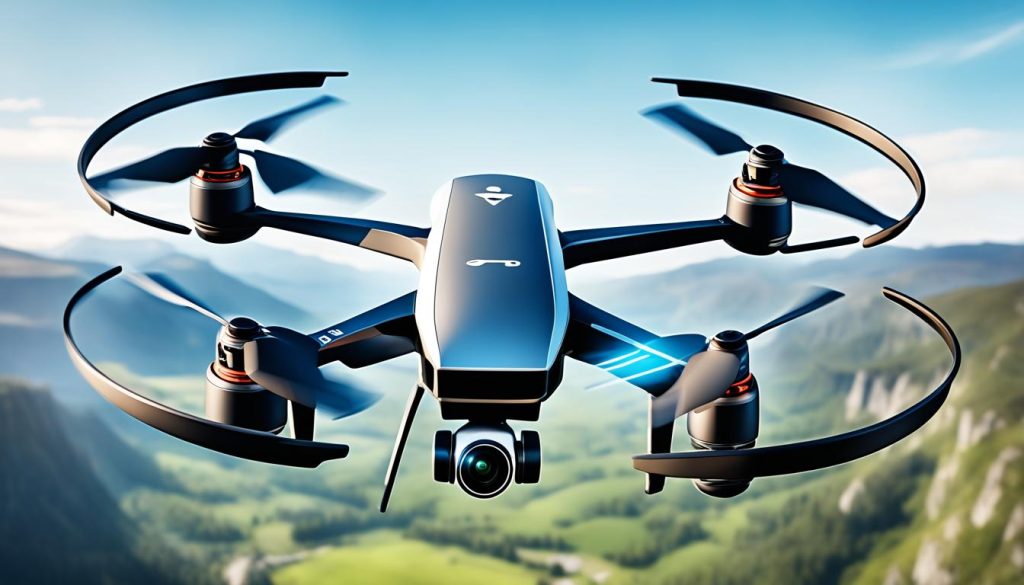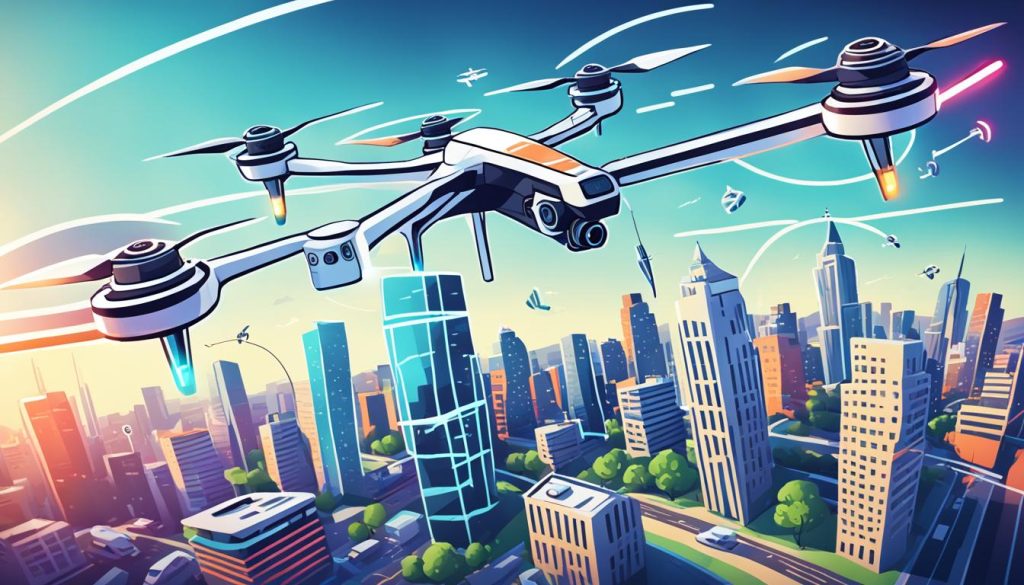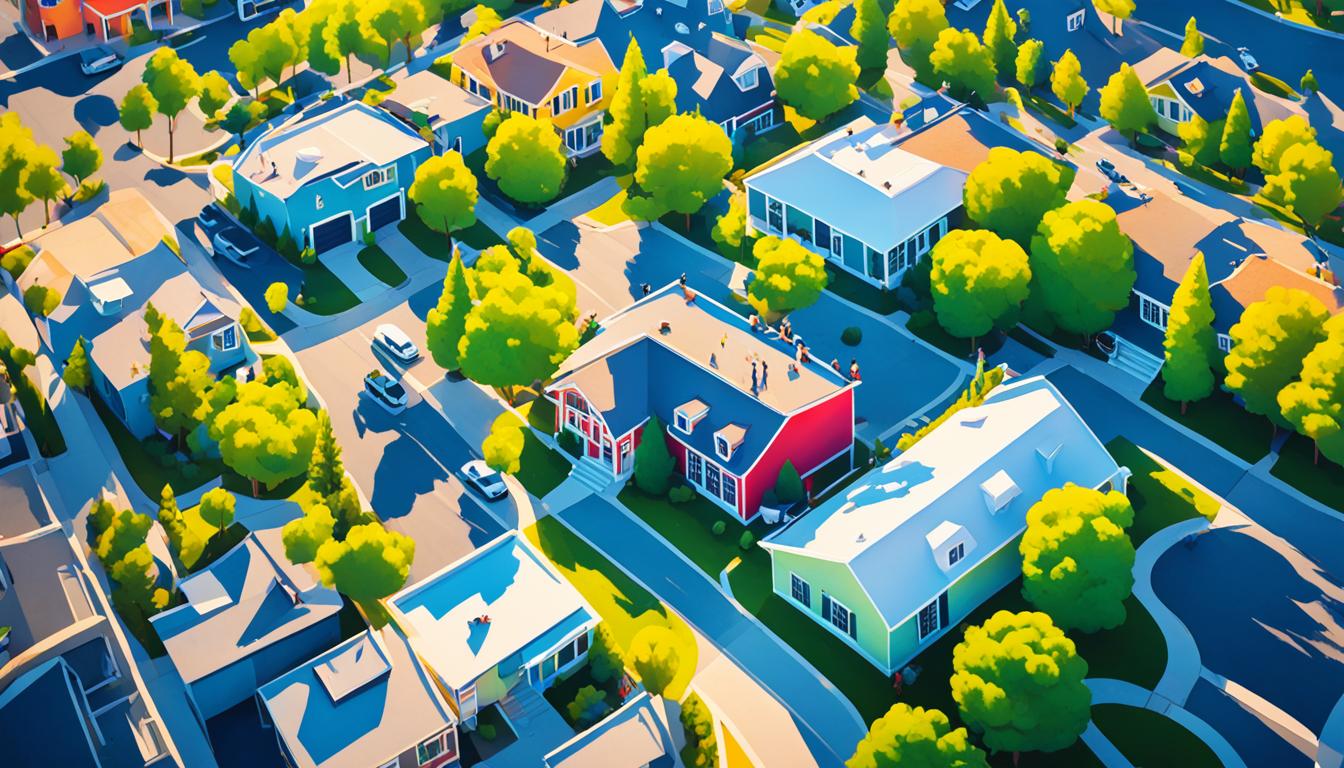Mastering aerial videography techniques can help you create stunning hyperlapse drone footage. This style of photography blends movement with time-lapse for eye-catching aerial shots. It’s a way to capture the beauty of the world from above.
Start by finding locations with lots of movement, like busy cities or waves. Then, tweak your camera’s settings. Adjust the interval timing, shutter speed, and white balance for clear, bright images while flying.
By fine-tuning these settings, you’ll improve your hyperlapse photography. You’ll make aerial content that grabs attention. The key is to mix motion, timing, and camera settings right. This creates a smooth flow of images that tell a story.
Understanding Hyperlapse Drone Photography
Hyperlapse drone photography takes time-lapse to a new level. It blends aerial shots with time manipulation. Let’s dive into this exciting field and see why it’s popular among drone fans.
What is hyperlapse photography?
Hyperlapse photography takes pictures while moving the camera. It makes a moving visual story that grabs the viewer. With drones, it opens new ways to be creative in the sky.
Benefits of using drones for hyperlapse
Drones bring special perks to hyperlapse:
- Aerial view: Get amazing shots from above
- Smooth movement: Get smooth motion that’s hard with handheld cameras
- Versatility: Get unique shots from hard-to-reach places
- Efficiency: Cover big areas quickly and easily
Key differences between hyperlapse and timelapse
Hyperlapse and timelapse both take pictures over time. But hyperlapse adds a twist:
| Feature | Timelapse | Hyperlapse |
|---|---|---|
| Camera movement | Stationary | Moving |
| Perspective | Fixed | Changing |
| Complexity | Simpler | More challenging |
| Visual impact | Time acceleration | Time and space manipulation |
To master hyperlapse drone photography, plan and execute with care. Think about wind and how fast your subject moves compared to your drone. With practice, you’ll make stunning time-lapse videos that catch everyone’s eye.
Using these tips will improve your hyperlapse projects. Try different speeds, angles, and subjects to find your style in aerial filmmaking.
Essential Equipment for Drone Hyperlapse
Creating stunning hyperlapse footage with drones needs the right gear. Your aerial camera setup is key for smooth, high-quality shots. Let’s look at the must-have equipment for your drone hyperlapse adventures.
A good drone is the base of your setup. Choose models like the DJI Mavic Air or Phantom 4 Pro, which are great for hyperlapse. These drones have timed shot intervals and advanced modes like Tap-To-Fly or Waypoint for precise control.
ND filters are a must for bright conditions. They help keep shutter speeds right without overexposing your footage. Get a set of high-quality ND filters that fit your drone’s camera.
Post-processing brings your hyperlapse to life. Drone video editing software is key for stabilizing footage and improving visuals. Top choices include:
- Adobe Premiere Pro
- DaVinci Resolve
- Final Cut Pro X
These programs have powerful tools to smooth out your hyperlapse and add color grading for your look.
| Equipment | Purpose | Example |
|---|---|---|
| Drone | Capture aerial footage | DJI Mavic Air 2 |
| ND Filters | Control exposure | PolarPro ND4/PL Filter |
| Editing Software | Post-processing | Adobe Premiere Pro |
With these essential tools, you’ll be ready to make amazing hyperlapse drone footage that catches everyone’s eye.
Choosing the Right Location for Your Hyperlapse
Finding the perfect spot for your hyperlapse shots is key to great drone footage. The right location can make your project stand out. So, think about a few things before you start filming.
Movement is Key
Search for scenes with lots of motion for your hyperlapse. Places like coasts with waves, busy harbors, or city streets are great. These spots add energy and make your footage captivating.
Wind Conditions Matter
Wind is important for drone hyperlapse shots. You want calm weather for smooth footage. Strong winds can shake the camera and ruin your shots. Always check the weather before you go.
Scout for Dynamic Locations
Explore places you might film before you start. Think about what’s moving, what’s in the background, and any obstacles. California’s Highway 1 is great for hyperlapse because of its beauty and movement. Find spots that mix nature with human life for interesting footage.
- Research popular landmarks and scenic routes in your area
- Visit locations at different times of day to assess lighting conditions
- Identify safe takeoff and landing spots for your drone
- Check for any local regulations or restrictions on drone flying
By picking your location wisely, you’ll get amazing hyperlapse shots and drone footage.
Optimize Camera Settings for Stunning Hyperlapse Drone Footage
To make amazing hyperlapse drone videos, you need to get your camera settings right. Let’s explore the key adjustments to improve your aerial shots.
Start by picking your shot intervals. A 2-5 second gap between frames is usually good. This creates smooth motion and captures enough detail.
Think about your image format. JPEG is fast to process, but RAW gives you more editing options. Pick based on what you plan to do with your footage.
Use a 16:9 aspect ratio for a movie-like look that fits most screens. This format is great for showing off wide scenes in hyperlapses.
Keep your white balance the same for consistent colors. A 5500K setting works well for daylight, but adjust if needed.
Shutter speed is key for clear images. Go for 1/60th of a second with an ND filter for a natural blur. This combo makes your hyperlapse look smooth.
| Setting | Recommendation | Purpose |
|---|---|---|
| Shot Interval | 2-5 seconds | Smooth motion in final video |
| Image Format | JPEG or RAW | Balance processing speed and editing flexibility |
| Aspect Ratio | 16:9 | Cinematic look, fits modern displays |
| White Balance | Locked (e.g., 5500K) | Consistent color throughout shoot |
| Shutter Speed | 1/60th with ND filter | Sharp images with natural motion blur |
These settings are just a starting point. Try different settings based on your scene, lighting, and drone. With practice, you’ll find the best settings for amazing hyperlapse drone videos.
Selecting the Ideal Interval Between Shots
Choosing the right interval between shots is key for great hyperlapse photography and time-lapse drone footage. The right interval makes your video smooth and engaging. The wrong one can make it choppy or boring.
Factors Affecting Interval Selection
When planning your hyperlapse drone shoot, think about these important factors:
- Subject movement speed
- Desired final video length
- Drone capabilities
- Processing time between shots
Fast-moving subjects need shorter intervals for smooth motion. Slower scenes can have longer gaps between shots. Check your drone’s manual for its limits.
Recommended Intervals for Different Scenarios
Here’s a guide for choosing intervals in different hyperlapse situations:
| Scenario | Recommended Interval | Notes |
|---|---|---|
| Slow-moving clouds | 5-10 seconds | Longer intervals create dramatic cloud movement |
| Busy city traffic | 2-3 seconds | Captures fluid vehicle motion |
| Sunset/sunrise | 15-30 seconds | Shows gradual light changes |
| Construction progress | 1-5 minutes | Depends on construction speed |
| Ocean waves | 1-2 seconds | Creates smooth wave patterns |
These are just starting points. Try different intervals to see what works best for your project. The right interval will make your hyperlapse videos stunning and engaging.
Mastering Shutter Speed for Sharp Images

Shutter speed is key to getting sharp images from the sky. When you’re setting up your drone camera for aerial shots, knowing how shutter speed affects your photos is crucial. The faster your drone moves, the faster your shutter speed should be to prevent blurry images.
For drones moving at 2.2 km/h (1.37 mph), a shutter speed of 1/8000 second helps avoid blur, leaving only 0.08mm of it. Choosing a slower speed of 1/2000 second means you’ll see about 0.3mm of blur. These small differences can greatly affect how clear your hyperlapse videos look.
When picking your shutter speed, think about these things:
- Drone speed
- Available light
- Desired motion blur effect
- Camera’s mechanical vs. electronic shutter capabilities
Many drone users like using mechanical shutter speeds, like 1/2000 second, for their dependability. Electronic shutter speeds, such as 1/8000 second, can reduce blur but might cause rolling shutter effects in some cases.
| Shutter Speed | Blur Amount (at 2.2 km/h) | Best Use Case |
|---|---|---|
| 1/8000 s | 0.08mm | Fast-moving subjects, bright conditions |
| 1/2000 s | 0.3mm | General aerial photography, balanced light |
| 1/1000 s | 0.6mm | Slower movements, low light situations |
Balance your shutter speed with aperture and ISO for the best shots. In bright scenes, ND filters might be needed to keep your shutter speed right without overexposing your photos. Trying out different shutter speeds will help you find the best for your drone and the scene.
Perfecting Exposure with Aperture and ISO
Mastering drone camera settings is key to getting great footage. You must balance aperture and ISO and think about using ND filters.
Balancing aperture for depth of field
Aperture controls how much light gets into your drone’s camera and the depth of field. For hyperlapse shots, use a smaller aperture (higher f-number) to keep more of the scene sharp. This makes your footage look crisp and detailed.
Managing ISO for noise reduction
Keep ISO low to reduce noise in your footage. Start with the lowest ISO and only increase it if needed. High ISO values can make your hyperlapse look grainy, lowering its quality.
Using ND filters for optimal exposure
Neutral Density (ND) filters are key for the right shutter speeds in bright conditions. They help you get the right exposure without changing other settings. For example, an ND32 filter might be needed for a 1/60th shutter speed in daylight, giving you smooth motion blur in your hyperlapse.
| Lighting Condition | Recommended ND Filter | Typical Shutter Speed |
|---|---|---|
| Bright Sunlight | ND32 or ND64 | 1/60 – 1/120 |
| Overcast | ND8 or ND16 | 1/30 – 1/60 |
| Sunset/Sunrise | ND4 or ND8 | 1/15 – 1/30 |
By adjusting these settings, you’ll be on your way to making stunning drone footage for your hyperlapse projects.
Flight Modes and Drone Speed Settings
Learning how to use flight modes and speed settings is key for amazing hyperlapse drone footage. These techniques are vital for smooth, professional-looking shots. Let’s dive into how to get the best out of your drone for hyperlapse photography.

Choosing the right flight mode is crucial for drone cinematography. Modern drones have special modes for hyperlapse. Tap-To-Fly and Waypoint modes are great for controlling your drone’s path.
Tap-To-Fly lets you set a path for your drone. It’s perfect for straight lines or simple curves. Waypoint mode is better for complex paths or circling around things.
Getting the right speed is also key. Your speed should match the scene and keep the framing steady. Start with 2 meters per hour, but adjust as needed.
| Scene Type | Recommended Speed | Flight Mode |
|---|---|---|
| Urban Landscape | 1-3 m/h | Waypoint |
| Natural Scenery | 2-4 m/h | Tap-To-Fly |
| Fast-moving Subjects | 4-6 m/h | Waypoint |
Practice these aerial videography techniques before your next hyperlapse shoot. Trying out different modes and speeds will help you find what works best. This will improve your drone cinematography skills.
Post-Processing Techniques for Hyperlapse Footage
Turning your raw drone footage into stunning videos takes skill in post-processing. Let’s look at key techniques to make your hyperlapse videos stand out. These methods help tell beautiful stories through visuals.
Software recommendations for editing
Choosing the right software is vital for editing hyperlapse footage. Adobe Premiere Pro and DaVinci Resolve are top picks for videographers. They have advanced tools for smoothing footage, tweaking colors, and adding effects.
Stabilization techniques
For captivating hyperlapse videos, smooth footage is crucial. Use warp stabilizer in Premiere Pro or the tool in DaVinci Resolve to fix shaky footage. Apply stabilization before adding effects or color changes for the best look.
Color grading and visual enhancements
Color grading turns drone footage into cinematic masterpieces. Begin by adjusting exposure and contrast. Then, fine-tune colors for a unified look. Use LUTs for quick, professional results or adjust manually to create your style.
Try adding vignettes, lens flares, or light leaks for more visual interest. Post-processing is an art. Experiment with techniques to develop your style. With practice, you’ll make hyperlapse videos that amaze viewers and highlight your drone skills.
Overcoming Common Challenges in Drone Hyperlapse
Creating dynamic hyperlapse shots with drones can be tricky. Wind, framing issues, and battery life often pose problems for aerial videography techniques. Let’s explore these challenges and how to tackle them head-on.
Wind can mess up your footage. Choose calm days for shooting or use a drone that can handle strong winds. If you’re flying in windy conditions, adjust your camera settings to fight the movement.
Keeping your framing steady is key for smooth hyperlapse shots. Use waypoints or practice manual control to keep your shot steady. Remember, even small changes can be noticeable in the final video.
Battery life is a big worry for long hyperlapse shoots. Plan your flight carefully and bring extra batteries. Think about using a drone with swappable batteries to keep shooting without stopping.
| Challenge | Solution |
|---|---|
| Wind interference | Choose calm days, use wind-resistant drones |
| Framing consistency | Utilize waypoints, practice manual control |
| Battery limitations | Plan flights, bring spares, use swappable batteries |
| Changing light conditions | Adjust settings on-site, use auto-exposure with caution |
Lighting changes can mess with your hyperlapse quality. Be ready to tweak your camera settings as needed. Auto-exposure can help, but be careful to avoid sudden brightness changes in your footage.
By tackling these common issues, you’ll be on your way to capturing stunning aerial hyperlapse videos. These videos will show off your creative vision and technical skills.
Conclusion
Learning how to make hyperlapse drone footage can open up new creative doors in aerial videography. By adjusting your camera settings, you can get amazing time-compressed aerial shots that will wow your audience.
Look for exciting locations and think about the wind. Also, work on getting your exposure right. Try different shot intervals and flight modes for cool effects. The right shutter speed, aperture, and ISO settings will give you clear, well-lit images.
Editing your hyperlapse videos is key to making them look great. Use stabilization and color grading to boost the look of your footage. As you get better at this, you’ll find your own style and improve drone cinematography.
With hard work and practice, you’ll make hyperlapse drone videos that really pop. Keep finding new places, tweaking your camera settings, and trying new things to get better at aerial videography.






